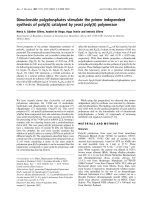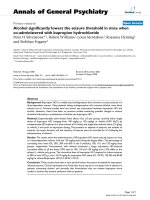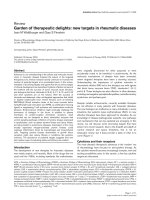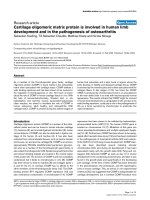Báo cáo y học: "Can we find the genes involved in complex traits" pptx
Bạn đang xem bản rút gọn của tài liệu. Xem và tải ngay bản đầy đủ của tài liệu tại đây (46.78 KB, 2 trang )
Genome Biology 2004, 5:347
comment
reviews
reports
deposited research
interactions
information
refereed research
Meeting report
Can we find the genes involved in complex traits?
Mathew Pletcher and Tim Wiltshire
Address: Genomics Institute of the Novartis Research Foundation, 10675 John Jay Hopkins Drive, San Diego, CA 92121, USA.
Correspondence: Tim Wiltshire. Email:
Published: 22 September 2004
Genome Biology 2004, 5:347
The electronic version of this article is the complete one and can be
found online at />© 2004 BioMed Central Ltd
A report on the third Complex Trait Consortium meeting,
Bar Harbor, USA, 6-9 July 2004.
The Complex Trait Consortium (CTC) [plex-
trait.org] came together for the first time two years ago in
Memphis, Tennessee to formalize a loose association of sci-
entists focused on using methods for mapping quantitative
trait loci (QTLs) to unlock the genetics of complex pheno-
types. The study of QTLs attempts to pinpoint the associa-
tions between the natural phenotypic and genotypic
variation found in existing populations for the purpose of
uncovering the mechanism of complex diseases. Since its
first meeting, the CTC has grown, and it met, in July, at The
Jackson Laboratory for its third annual meeting to evaluate
the tools and resources that are available to advance the
study of QTLs and to review the progress towards identifica-
tion of quantitative trait genes (QTGs). The largest impact
on mouse genetics, and not just QTL studies, in the short
history of the CTC has come from the public accessibility of a
nearly complete mouse-genome assembly. The importance
of that achievement carried through the entire meeting from
Rick Woychik’s (The Jackson Laboratory, Bar Harbor, USA)
introductory remarks to spirited concluding discussions
about the appropriateness of current strategies to generate
genome assemblies of additional strains of mice.
The presence of a mouse genome assembly provides the
context with which to analyze the growing resource of
single-nucleotide polymorphisms (SNPs) for the purposes
of studying and defining the genomic ancestry of the
common inbred strains. Using a SNP set of 1,513 markers in
60 strains of mice, Ken Paigen (The Jackson Laboratory)
showed that large regions of the mouse genome, including a
40 megabase (Mb) region on the X chromosome, exist in
linkage disequilibrium (LD). LD is a measure of the co-
inheritance of markers, whereby the expected frequencies
of haplotypes are not found within a population. By
Paigen’s estimate, over 50% of the genome of inbred mouse
strains exists in LD blocks of more than 6 Mb, meaning that
there are large segments of the genome that are selectively
co-inherited in order to maintain complementary allelic
combinations in the neighboring genes (that is, recombina-
tion in this region is selected against). One of us (T.W.) dis-
cussed his extension of the current SNP data to over 10,000
markers in 48 different strains. He also proposed the re-
evaluation of the idea of in silico mapping, presenting work
in which haplotype structure was inferred from SNP data
and statistical associations were found between those
inferred haplotypes and phenotypic distributions among
the inbred strains.
Mark Daly (Whitehead Institute, Cambridge, USA) also
demonstrated the utility of defining ancestral relationships
on the basis of SNP patterns between strains, but as a means
to follow-up initial QTL mapping rather than for defining
new QTLs. By combining SNP data with information from
multiple crosses that defined the QTL, and hypothesizing
that the SNP pattern has to be different in the area of the
QTG, the candidate region can be cut down to less than a
megabase. This same methodology was used by a number of
speakers as a means to narrow down candidate gene lists for
their favorite QTLs. Daly also announced his group’s plan to
begin work on an Affymetrix-style ‘SNP chip’ that will be
used to provide strain genotypes for 200,000 SNP markers.
This announcement of the further extension of current SNP
data was added to by Richard Mott (Wellcome Trust Centre
for Human Genetics, Oxford, UK), who solicited mouse
strains to be typed against a 15,000-SNP panel that will be
used to genotype a 2,000-strain heterogeneous stock set,
which is currently being used to investigate behavioral QTLs.
Mott’s solicitation led to the inclusion in his genotyping
effort of all available recombinant inbred strains and inbred
lines that make up the ‘Priority List’ of the Mouse Phenome
Project [ />Combining genomic assembly data, genotyping data and
microarray expression data has led to the rapid expansion of
the study of expression QTLs, or eQTLs - variations in gene-
expression level that are responsible for quantitative varia-
tion in phenotype. Ken Manly (University of Tennessee,
Memphis, USA) presented his web-based tool, WebQTL
[] and the QTL Reaper software package,
for studying the associations between expression differences
in genes and allelic patterns in recombinant inbred lines.
Even considering the false-positive rates associated with this
methodology, John Belknap (Oregon Health and Science
University, Portland, USA) and Eric Schadt (Rosetta Inphar-
matics, Kirkland, USA), demonstrated successful integration
of eQTL analysis into their respective studies of alcohol pref-
erence and obesity phenotypes. Kent Hunter (National
Cancer Institute, Bethesda, USA) showed how informative
eQTLs can be even without an understanding of the underly-
ing genetics that produced them. He confirmed in mice that
the expression levels of particular genes correlate with, and
can even predict, the susceptibility of different strains to
metastatic tumors. If the susceptible expression pattern can
be reset - for example, Hunter was able to accomplish this
with administration of caffeine - to resemble resistant
expression patterns, the mouse is no longer susceptible to
tumorigenesis or metastasis.
Despite the initial success of integrating the mouse genome
assembly into the process of QTL mapping, it is certainly not
the final answer for identifying QTGs, and many other tools
and concepts were discussed that might have just as large an
effect. A recent grant solicitation (from the National Insti-
tute of Environmental Health Sciences) for the resequencing
of 15 additional strains of mice beyond the current C57BL6/J
assembly was welcomed as a means of further defining
haplotype patterns. It was suggested that an approach
focused on the coding regions of the genes could be most
beneficial, ensuring greater overlap of sequences between
more strains and providing a catalog of the SNPs likely to be
most informative. Woychik described preliminary discus-
sions for the creation of a public knockout mouse library.
Conversation focused on whether such a library should be
purchased from a commercial entity or regenerated publicly,
and whether strains would be more useful if they were all
conditional knockouts, although this resource is currently
only at the contemplative stage with no funding. Plans for
the ‘collaborative cross’, a 1,000 line recombinant inbred
resource developed from a cross of eight different strains,
were organized by Rob Williams (University of Tennessee
Health Science Center, Memphis, USA) and Gary Churchill
(The Jackson Laboratory), and some of the first breeding
crosses might be initiated this year by Churchill. The goal of
the collaborative cross is to be able to define QTLs of only a
megabase in size, although the statistical models for analyz-
ing the data from such a cross are still being developed. Mott
introduced the idea that outbred mice could be used both to
confirm and to refine mapping done in inbred strains, as
well as to provide additional diversity for the identification
of new QTLs. Work by Karl Jepsen (Mount Sinai School of
Medicine, New York, USA) on bone fragility underscored the
benefit of incorporating distinct disciplines, in this case
engineering, in defining and understanding new phenotypes.
He also pointed out the importance of understanding the
relationships between closely related phenotypes, because
their interdependence could mean that the characteristic
assumed to be under investigation is actually secondary to a
phenotype that is not of interest. Likewise, David Threadgill
(University of North Carolina, Chapel Hill, USA) presented
clear examples of how environmental contributions such as
bacterial flora can drastically change the phenotypic readout
of genetically identical mice.
In the end, the discussion of current and future resources,
uses of the genome assemblies, different kinds of crosses
and phenotyping all feed back to the idea of moving from
QTL to QTG, and for that the most positive news to the field
of QTLs and complex disease study came from Bev Paigen
(The Jackson Laboratory). She has been able to progress to
QTGs for no fewer than five loci by incorporating traditional
genetic cross data with haplotype structure, human QTL
synteny, and, in the case of the Abca1 gene, expression data.
She provided some of the best evidence that a critical mass
of converging information and understanding has now
tipped the scale and will, in the near future, allow more rapid
progress to the identification of genes from loci of interest.
347.2 Genome Biology 2004, Volume 5, Issue 10, Article 347 Pletcher and Wiltshire />Genome Biology 2004, 5:347









